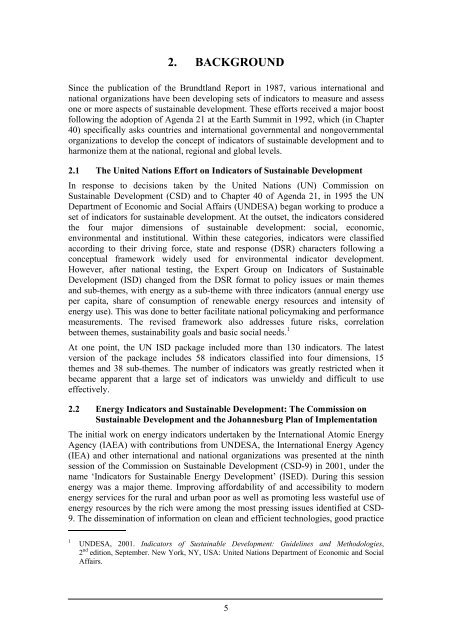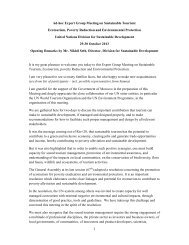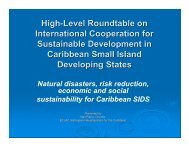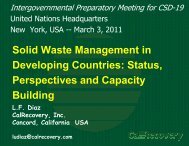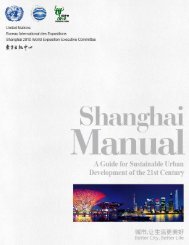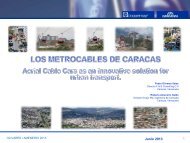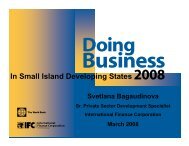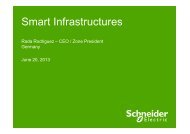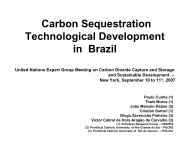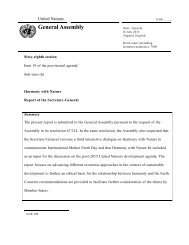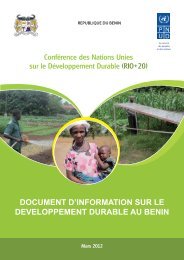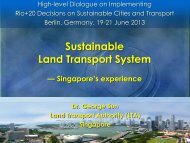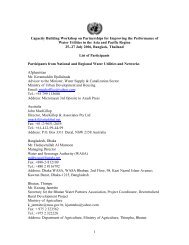Energy Indicators for Sustainable Development ... - IAEA Publications
Energy Indicators for Sustainable Development ... - IAEA Publications
Energy Indicators for Sustainable Development ... - IAEA Publications
Create successful ePaper yourself
Turn your PDF publications into a flip-book with our unique Google optimized e-Paper software.
2. BACKGROUNDSince the publication of the Brundtland Report in 1987, various international andnational organizations have been developing sets of indicators to measure and assessone or more aspects of sustainable development. These ef<strong>for</strong>ts received a major boostfollowing the adoption of Agenda 21 at the Earth Summit in 1992, which (in Chapter40) specifically asks countries and international governmental and nongovernmentalorganizations to develop the concept of indicators of sustainable development and toharmonize them at the national, regional and global levels.2.1 The United Nations Ef<strong>for</strong>t on <strong>Indicators</strong> of <strong>Sustainable</strong> <strong>Development</strong>In response to decisions taken by the United Nations (UN) Commission on<strong>Sustainable</strong> <strong>Development</strong> (CSD) and to Chapter 40 of Agenda 21, in 1995 the UNDepartment of Economic and Social Affairs (UNDESA) began working to produce aset of indicators <strong>for</strong> sustainable development. At the outset, the indicators consideredthe four major dimensions of sustainable development: social, economic,environmental and institutional. Within these categories, indicators were classifiedaccording to their driving <strong>for</strong>ce, state and response (DSR) characters following aconceptual framework widely used <strong>for</strong> environmental indicator development.However, after national testing, the Expert Group on <strong>Indicators</strong> of <strong>Sustainable</strong><strong>Development</strong> (ISD) changed from the DSR <strong>for</strong>mat to policy issues or main themesand sub-themes, with energy as a sub-theme with three indicators (annual energy useper capita, share of consumption of renewable energy resources and intensity ofenergy use). This was done to better facilitate national policymaking and per<strong>for</strong>mancemeasurements. The revised framework also addresses future risks, correlationbetween themes, sustainability goals and basic social needs. 1At one point, the UN ISD package included more than 130 indicators. The latestversion of the package includes 58 indicators classified into four dimensions, 15themes and 38 sub-themes. The number of indicators was greatly restricted when itbecame apparent that a large set of indicators was unwieldy and difficult to useeffectively.2.2 <strong>Energy</strong> <strong>Indicators</strong> and <strong>Sustainable</strong> <strong>Development</strong>: The Commission on<strong>Sustainable</strong> <strong>Development</strong> and the Johannesburg Plan of ImplementationThe initial work on energy indicators undertaken by the International Atomic <strong>Energy</strong>Agency (<strong>IAEA</strong>) with contributions from UNDESA, the International <strong>Energy</strong> Agency(IEA) and other international and national organizations was presented at the ninthsession of the Commission on <strong>Sustainable</strong> <strong>Development</strong> (CSD-9) in 2001, under thename ‘<strong>Indicators</strong> <strong>for</strong> <strong>Sustainable</strong> <strong>Energy</strong> <strong>Development</strong>’ (ISED). During this sessionenergy was a major theme. Improving af<strong>for</strong>dability of and accessibility to modernenergy services <strong>for</strong> the rural and urban poor as well as promoting less wasteful use ofenergy resources by the rich were among the most pressing issues identified at CSD-9. The dissemination of in<strong>for</strong>mation on clean and efficient technologies, good practice1UNDESA, 2001. <strong>Indicators</strong> of <strong>Sustainable</strong> <strong>Development</strong>: Guidelines and Methodologies,2 nd edition, September. New York, NY, USA: United Nations Department of Economic and SocialAffairs.5


